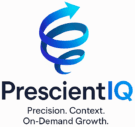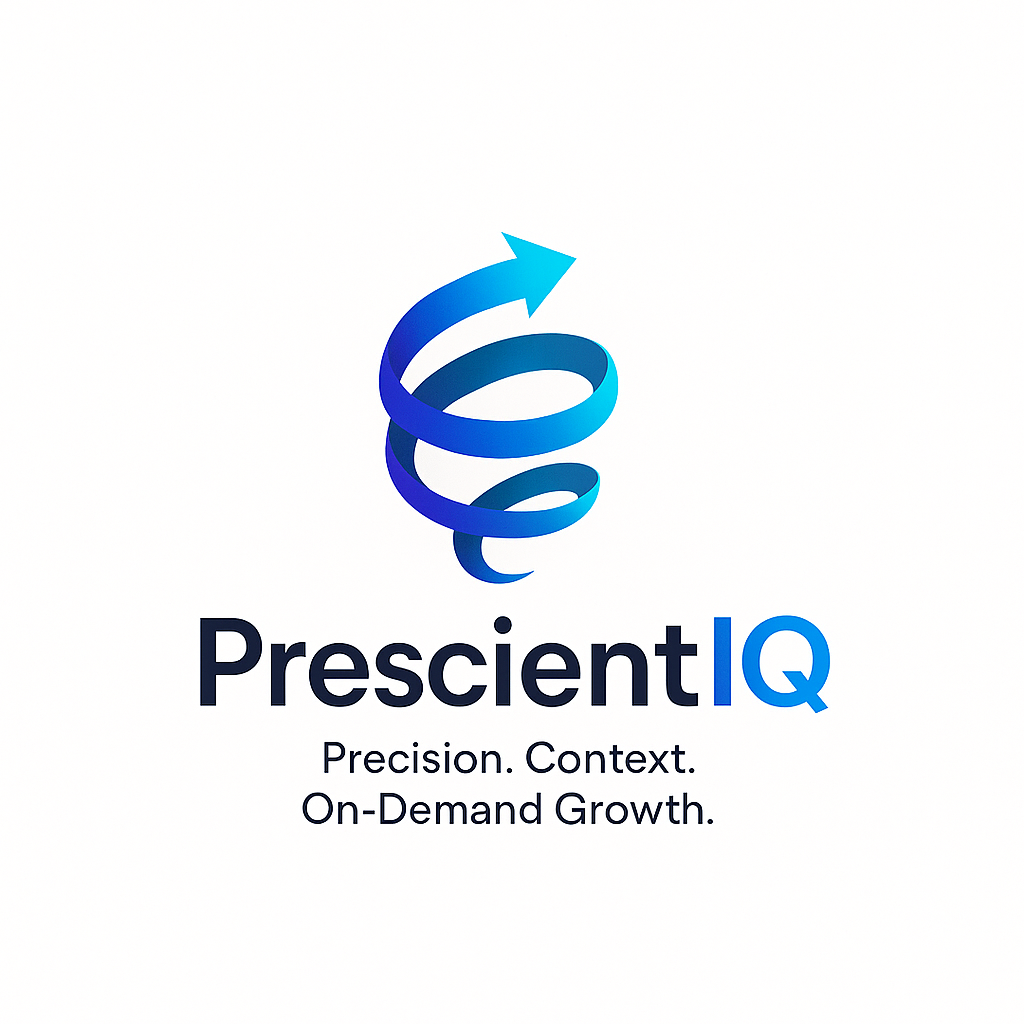PrescientIQ: Pre-Factual Simulation to Optimize Strategy & Win Boardroom Confidence
Learn How to Use PrescientIQ: Pre-Factual Simulation to Optimize Strategy & Win Boardroom Confidence.
In uncertain markets, where speed and agility separate winners from laggards, organizations need more than rear-view dashboards.
They need a way to see tomorrow’s terrain before they commit resources, and to present strategic choices to the board with clarity, rigor, and confidence.
PrescientIQ, powered by next-generation pre-factual simulation, is designed precisely for that purpose: transform strategy from guesswork into experiment, from intuition into guided decisioning, from uncertainty into boardroom-grade confidence.
This post explores the concept, competitive imperative, and architecture, and explains how your leadership team can leverage this capability to drive growth with clarity.
The Need: Why Boards and Executives Demand More Than Forecasts

From Hindsight to Foresight—and Beyond
Traditional analytics and AI tools today focus on descriptive (“What happened?”) and predictive (“What is likely to happen?”) layers.
Many firms have made progress in those domains. But as many strategy leaders will attest:
- Predictive models are only as good as their assumptions and seldom offer clarity on how to act.
- Forecasts can’t easily surface the implications of alternative decisions.
- Boards often push back: “Show me the downside, show me the tradeoffs, show me why this path is better than that one — not just a single forecast curve.”
Pre-factual simulation addresses exactly that gap. Instead of asking, “What will happen if things continue?” you ask: “What will likely happen if we do X, Y, or Z?”
The system simulates multiple possible futures given alternate strategic moves so that leadership can make decisions with a preview of multiple outcome paths.
As described in Matrix Marketing’s article on pre-factual simulation:
“It’s not merely forecasting, but simulating outcomes under hypothetical interventions … enabling sales and marketing teams to engineer outcomes proactively rather than react to them.” Matrix Marketing Group
By moving from reactive to proactive, PrescientIQ injects structure and rigor into strategy — and gives boards confidence in seeing not just projections, but decision-anchored simulations.
The Advanced Engine of Modern Marketing Mix Modeling: Bayesian Markov Chain Monte Carlo (MCMC)
Bayesian Markov Chain Monte Carlo (MCMC) methods serve as a core engine for advanced analytical models, particularly in the complex domain of Marketing Mix Modeling (MMM).
In essence, MCMC is a sophisticated simulation engine that intelligently explores thousands of possibilities to determine the most likely values for key business drivers, such as the true impact of an advertising channel or its point of diminishing returns. In modern MMM frameworks like Google’s Meridian
AI Marketing Maturity Ladder
A roadmap for evolving from automation to autonomous, explainable growth — powered by PrescientIQ.
Ladder Stages
Manual → Assisted
Unify data and automate basics with a semantic CDP: predictive lead scoring, campaign setup, baseline attribution.
Connected → Predictive
Forecast pipeline, surface next-best actions, and gain transparency into the “why” behind performance.
Predictive → Prescriptive
Run Pre‑Factual Simulation to test scenarios before spending: budget shifts, channel mix, creative strategies.
Prescriptive → Autonomous
Close the loop with autonomous orchestration: dynamic budgets, self‑correcting journeys, continuous learning.
Autonomous → Ethical & Transparent
Governance and glass‑box explainability: audit trails, compliance, and board‑grade confidence.
Implementing the Model
AI Beginner: Start with accessible native tools to unlock efficiency — while noting creative and compliance limits.
Developing & Intermediate: Add 1–2 specialized agents for high‑impact wins (creative production, lead nurturing).
Advanced & Expert: Orchestrate a fully integrated AI‑native ecosystem (native + third‑party agents) enabling strategies like Pair Selling and converting marketing into a proprietary growth engine.
Why a Hybrid Stack?
Blend the simplicity of native AI with the power of specialized agents to turn your stack into a strategic asset — automating the repetitive and elevating human creativity.
Native vs Specialized AI — Decision Matrix
When to Leverage Native AI Tools
- Foundational automation: budget optimization, auto placements, high‑volume campaigns
- When seamless platform integration is the top priority
- Tasks with limited creative nuance or regulatory complexity
When to Invest in Specialized AI Solutions
- On‑brand, compliant, emotionally resonant creative (copy & visuals)
- Hyper‑personalization and autonomous prospecting/sales workflows
- Distinct competitive edge through deeper AI capabilities
Strategic Imperatives: Volatility, Speed & Accountability
Several macro and industry trends make this a timely offering:
Increased volatility & complexity
Markets, customer behaviors, competitive moves, supply chain shocks — all create environments where static plans fail. Executives must simulate and stress-test more frequently.
Shorter feedback cycles
The cost of error compounds quickly. Being able to rehearse “what if” choices in silico reduces real-world missteps.
Board accountability & scrutiny
Boards expect more rigor, scenario planning, stress-testing, and sensitivity analysis. Leadership teams that deliver a single curve forecast often fall short under scrutiny.
AI maturity rising
As organizations mature in data, models, and decision infrastructure, they are ready for the next frontier: simulation over forecasting. Indeed, many modern martech and growth stacks are embedding predictive AI in planning and activation. MatrixLabX
Trust through transparency
Black-box forecasts breed skepticism.
Simulation frameworks that expose drivers, assumptions, and sensitivity, however, build credibility and trust across leadership.
In effect, PrescientIQ enables a shift: from “forecasting as art” to strategic simulation as a discipline.
What Is PrescientIQ? Key Value Pillars
PrescientIQ is a growth suite built around AI-native, autonomous decisioning, with pre-factual simulation as its core differentiator.
The product promises the following value pillars:
Precision through simulation
Create multiple scenario runs (e.g., baseline, conservative, aggressive) and compare outcomes across revenue, cost, ROI, funnel conversion, and other key metrics.
Contextual coherence
The simulation is not built in isolation — it lives atop unified marketing, sales, and revenue data; it’s contextual to your market, segments, and customer behavior patterns (the “context” in “precision, context, on-demand growth”). YouTube
On-demand agility
Leadership can spin up new scenarios quickly (e.g., “increase ad spend 10 % now,” “reallocate budget across channels,” “improve lead response times”) and see projected outcomes in minutes.
Explainable decision insight
Each scenario is backed by transparent modeling assumptions, driver attribution, and sensitivity analysis — not magic numbers.
Board-grade deliverables
The output is formatted in a way that executives and boards can digest: side-by-side charts, “what moved the needle” insights, and downside/upsides clearly delineated.
Autonomous system integration (future state)
Over time, PrescientIQ can close the loop by pushing optimized scenario parameters into campaign execution flows, thereby automating parts of the activation fabric.
A recent blog from the product’s team calls it “the crystal ball of growth”, describing PrescientIQ as combining autonomous sales + marketing with simulation-driven strategy. Matrix Marketing Group
In short, PrescientIQ is the flight simulator for GTM strategy.
How Pre-Factual Simulation Works (Under the Hood)
Here is a simplified “anatomy” of how it operates:
This architecture ensures that simulation is not a toy, but a robust decision-making engine that respects data, uncertainty, and transparency.
PrescientIQ’s simulation engine operates through seven key stages:
- Data Foundation & Unified Profiles: Ingests and normalizes data from various platforms to build unified customer and prospect profiles, enriched with engineered features.
- Baseline Modeling & Causal Estimation: Trains predictive models and employs causal inference to deconfound attribution, measuring incremental effects and fitting elasticities per channel and segment.
- Scenario Definition: Users define “levers” (e.g., budget changes, lead response time) and constraints within the UI, allowing for parameterized changes over time.
- Simulation Engine: Runs multiple stochastic (Monte Carlo) simulations for each scenario, propagating changes across stages and accounting for feedback loops, providing ranges and confidence intervals.
- Insights, Explanation & Sensitivity: Presents key metrics, waterfall charts, sensitivity analyses, and drill-downs, including confidence and risk bounds.
- Export & Board Deliverables: Generates scenario summaries in presentable formats (PDF, slides, dashboards) and detailed playbooks, with optional API integration.
- Governance, Versioning & Audit Trail: Provides version control, role-based permissioning, and full audit logs for transparency and accountability.
This architecture ensures a robust, data-driven, and transparent decision-making engine.
Use Cases & Strategic Impact
Let’s walk through some illustrative use cases and how PrescientIQ delivers strategic impact (and boardroom confidence).
Use Case A: Marketing Budget Reallocation
Scenario: A CMO wants to reallocate part of the ad budget from broad display to amplified remarketing + content. She fears that the new mix might underperform.
With PrescientIQ:
- Define baseline (current spend by channel).
- Create Scenario A: Shift 20% of display spend into remarketing and content.
- Run simulation and compare: incremental revenue, ROI, conversion lift, funnel impact, risk range.
- See sensitivity: which change contributed most to lift (e.g., remarketing bump, improved message sequencing).
- Use the output to present to the CFO and board: “This reallocation yields +8 % incremental revenue with a 95 % confidence range of +5% to +12%; downside risk is –1.2% in the worst case.”
Impact: Decision anchored in data, not guesswork. Leadership sees tradeoffs clearly.
Use Case B: Sales Process Optimization
Scenario: You hypothesize that reducing lead response time from 24h → 6h will improve funnel conversion significantly.
With PrescientIQ:
- Create a scenario with the lead response time lever changed.
- Simulation shows influence across funnel: leads → opportunities → closed pipeline.
- You also simulate partial adoption (e.g., only 50% of leads get a 6-hour response) vs full adoption.
- See ROI uplift, conversion shift, revenue delta.
Impact: Operations, sales leaders, and the board can assess whether investing in tools or staffing to reduce latency is a worthwhile lever.
Use Case C: What-if Stress Testing for Downturn
Scenario: You want to stress-test your strategy if the market contracts by 10% or your ad costs rise.
With PrescientIQ:
- Build scenario(s) modeling adverse conditions (budget constraints, cost inflation, lower conversion).
- Compare resilient strategies (e.g., shifting to lower-cost channels, deeper segmentation).
- Identify which levers are robust under stress and build fallback playbooks.
Impact: You enter board discussions with contingency plans, not speculative worry.
Use Case D: Board-Level Strategy & M&A
Scenario: Evaluating a new investment in a new region or vertical, or a potential acquisition path, and need to simulate outcomes.
With PrescientIQ:
- Model base case and alternate case with investment in new vertical (e.g., spend, staffing, ramp).
- Project returns, time to breakeven, and sensitivity to assumptions.
- Overlay competitive scenario: competitor response, ad cost increases.
- Present to the board with a full range of outcomes and a recommended path.
Impact: The board sees the logic, assumptions, and risk bounds. Decision becomes a guided bet rather than a leap of faith.
How PrescientIQ Inspires Boardroom Confidence
Beyond the technical power, what elevates a platform like this to boardroom trust is how it speaks to executive needs:
- Transparency of Assumptions: Make visible levers and model parameters for every simulation. Executives don’t have to accept a magic forecast — they can probe, tweak, override.
- Scenario Comparison & Risk Spectrum: Seeing a best / base / worst case side-by-side sharpens credibility. Boards love to see downside guardrails.
- Sensitivity & Attribution of Drivers: You don’t just get “+10% revenue” — you see which lever contributed most (e.g., budget shift, messaging, sales latency). That tells a narrative executives can buy.
- Probabilistic Boundaries & Confidence Intervals: Rather than deterministic outputs, you deliver ranges (e.g., 95% confidence) and highlight uncertainty, which is more honest and credible.
- High-Fidelity Data Backing: Because the simulations run over real data (customer-level, channel-level, behavior-level), they feel grounded — not theoretical.
- Versioning, Traceability & Auditability: Board-level decisions demand accountability: “Who made this assumption? When? Why?” — Versioning and audit logs satisfy governance.
- Executable Playbooks: The bridge from scenario to action is vital. Boards dislike “analysis paralysis.” PrescientIQ ensures that decisions can be effectively translated into actionable execution steps.
- Alignment with Board Expectations: Boards today demand more rigorous planning, scenario stress-testing, downside guardrails, and disciplined pathing. PrescientIQ aligns with evolving board best practices on governance and oversight (especially in AI-enabled environments). EY+2Harvard Law Corporate Governance Forum+2
In sum, using PrescientIQ transforms your board narrative from “We believe this will happen” to “Here’s what will likely happen, here’s the risk curve, here’s why we choose this path.”



